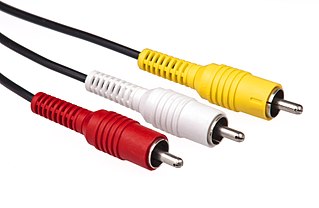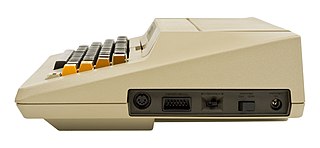
The Sup 'R' Mod II is an RF modulator which was sold by M&R Enterprises in the late 1970s and early 1980s. It connects computers and other devices with composite video outputs, to a television. [1]

The Sup 'R' Mod II is an RF modulator which was sold by M&R Enterprises in the late 1970s and early 1980s. It connects computers and other devices with composite video outputs, to a television. [1]
Apple Computer wanted to provide Apple II computers with color output on a television, but had trouble getting FCC approval because the RF modulation solution is too noisy. Apple made an arrangement with a small nearby company, M&R Enterprises, to manufacture and sell the devices. Apple could not sell the modulator and computer as a package, but retail computer dealers could sell both devices to the end user. [2]
Marty Spergel, who ran M&R Enterprises, was told by Steve Jobs that it might sell up to 50 units a month. Spergel later estimated that he had sold about 400,000 units. [3]
The Sup 'R' Mod II began selling in April 1978, for US$29.95(equivalent to about $100 in 2023). [4]
The Sup 'R' Mod II kit has a small printed circuit board, an antenna switch, and a coaxial cable with a ferrite core and RCA connectors. Composite video is received by the circuit board through a short cable terminating in a Molex connector, which plugs into a header on the Apple II motherboard. Input can also be provided through an RCA connector. The output of the RF modulator goes out through a coaxial cable to the antenna switch. [5] [6]
The antenna switch allows the user to select between television broadcasts and computer output. The television antenna connects to inputs on the switch, and the switch output connects to the back of the television. The connections use screw terminals with spade lugs. Moving the switch from "TV" to "GAME PLAY" selects the computer output.
The modulator presents a color signal on UHF channel 33. [4]
A communications system or communication system is a collection of individual telecommunications networks systems, relay stations, tributary stations, and terminal equipment usually capable of interconnection and interoperation to form an integrated whole. The components of a communications system serve a common purpose, are technically compatible, use common procedures, respond to controls, and operate in union.
A signal generator is one of a class of electronic devices that generates electrical signals with set properties of amplitude, frequency, and wave shape. These generated signals are used as a stimulus for electronic measurements, typically used in designing, testing, troubleshooting, and repairing electronic or electroacoustic devices, though it often has artistic uses as well.

An RF modulator is an electronic device used to convert signals from devices such as media players, VCRs and game consoles to a format that can be handled by a device designed to receive a modulated RF input, such as a radio or television receiver. Its input is a baseband signal, which is used to modulate a radio frequency source.

SCART is a French-originated standard and associated 21-pin connector for connecting audio-visual (AV) equipment. The name SCART comes from Syndicat des Constructeurs d'Appareils Radiorécepteurs et Téléviseurs, "Radio and Television Receiver Manufacturers' Association", the French organisation that created the connector in the mid-1970s. The related European standard EN 50049 has then been refined and published in 1978 by CENELEC, calling it péritelevision, but it is commonly called by the abbreviation péritel in French.

Composite video is an baseband analog video format that typically carries a 405, 525 or 625 line interlaced black and white or color signal, on a single channel, unlike the higher-quality S-Video and the even higher-quality component video.

The RCA connector is a type of electrical connector commonly used to carry audio and video signals. The name RCA derives from the company Radio Corporation of America, which introduced the design in the 1930s. The connector’s male plug and female jack are called RCA plug and RCA jack.

Component video is an analog video signal that has been split into two or more component channels. In popular use, it refers to a type of component analog video (CAV) information that is transmitted or stored as three separate signals. Component video can be contrasted with composite video in which all the video information is combined into a single signal that is used in analog television. Like composite, component cables do not carry audio and are often paired with audio cables.
This is an index of articles relating to electronics and electricity or natural electricity and things that run on electricity and things that use or conduct electricity.

A balun is an electrical device that allows balanced and unbalanced lines to be interfaced without disturbing the impedance arrangement of either line. A balun can take many forms and may include devices that also transform impedances but need not do so. Sometimes, in the case of transformer baluns, they use magnetic coupling but need not do so. Common-mode chokes are also used as baluns and work by eliminating, rather than rejecting, common mode signals.

A cable television headend is a master facility for receiving television signals for processing and distribution over a cable television system. A headend facility may be staffed or unstaffed and is typically surrounded by some type of security fencing. The building is typically sturdy and purpose-built to provide security, cooling, and easy access for the electronic equipment used to receive and re-transmit video over the local cable infrastructure. One can also find head ends in power-line communication (PLC) substations and Internet communications networks.

A tuner is a subsystem that receives radio frequency (RF) transmissions, such as FM broadcasting, and converts the selected carrier frequency and its associated bandwidth into a fixed frequency that is suitable for further processing, usually because a lower frequency is used on the output. Broadcast FM/AM transmissions usually feed this intermediate frequency (IF) directly into a demodulator that converts the radio signal into audio-frequency signals that can be fed into an amplifier to drive a loudspeaker.

A composite monitor or composite video monitor is any analog video display that receives input in the form of an analog composite video signal to a defined specification. A composite video signal encodes all information on a single conductor; a composite cable has a single live conductor plus earth. Other equipment with display functionality includes monitors with more advanced interfaces and connectors giving a better picture, including analog VGA, and digital DVI, HDMI, and DisplayPort; and television (TV) receivers which are self-contained, receiving and displaying video RF broadcasts received with an internal tuner. Video monitors are used for displaying computer output, closed-circuit television and other applications requiring a two-dimensional monochrome or colour image.
A radio transmitter or receiver is connected to an antenna which emits or receives the radio waves. The antenna feed system or antenna feed is the cable or conductor, and other associated equipment, which connects the transmitter or receiver with the antenna and makes the two devices compatible. In a radio transmitter, the transmitter generates an alternating current of radio frequency, and the feed system feeds the current to the antenna, which converts the power in the current to radio waves. In a radio receiver, the incoming radio waves excite tiny alternating currents in the antenna, and the feed system delivers this current to the receiver, which processes the signal.

Single-cable distribution is a satellite TV technology that enables the delivery of broadcast programming to multiple users over a single coaxial cable, and eliminates the numerous cables required to support consumer electronics devices such as twin-tuner digital video recorders (DVRs) and high-end receivers.

A digital television adapter (DTA), commonly known as a converter box or decoder box, is a television tuner that receives a digital television (DTV) transmission, and converts the digital signal into an analog signal that can be received and displayed on an analog television set. Some also have an HDMI output since some TVs with HDMI do not have a digital tuner. The input digital signal may be over-the-air terrestrial television signals received by a television antenna, or signals from a digital cable system. It normally does not refer to satellite TV, which has always required a set-top box either to operate the big satellite dish, or to be the integrated receiver/decoder (IRD) in the case of direct-broadcast satellites (DBS).

Netgear's Digital Entertainer line of products are digital media players that can pull multimedia content from home computers to the typical audio/video entertainment center. There are three products in the line, the EVA700, the HD EVA8000 and the current EVA9150 Digital Entertainer Elite. All support high definition video, the EVA700 via component output up to 1080i and the EVA8000/EVA9000 up to 1080p with both component and HDMI connectors. All models support audio, video, image and streaming audio and video formats and can be networked via wired and wireless Ethernet. The EVA700 is Intel Viiv certified.
Analog passthrough is a feature found on some digital-to-analog television converter boxes. Boxes without the analog passthrough feature only allow older, analog-only TVs to view digital TV. Those with analog pass-through allow both digital and analog television to be viewed on older TVs.
Dimensia was RCA's brand name for their high-end models of television systems and their components produced from 1984 to 1989, with variations continuing into the early 1990s, superseded by the ProScan model line. After RCA was acquired by General Electric in 1986, GE sold the RCA consumer electronics line to Thomson SA which continued the Dimensia line. They are significant for their wide array of advanced features and for being the first television receiver systems to feature a built in computer, somewhat of an early incarnation of a smart TV, but without internet access. In 1985, RCA released the Digital Command Component System, a fully integrated audio system that permitted the full functionality of Dimensia audio components without a Dimensia monitor. The name "Dimensia" actually dates back to the early 1970s when RCA used the term for an enhanced spatial stereo effect which they called "Dimensia IV". The tagline for the Dimensia was The Next Dimension in Sight and Sound.
Audio connectors and video connectors are electrical or optical connectors for carrying audio or video signals. Audio interfaces or video interfaces define physical parameters and interpretation of signals. For digital audio and digital video, this can be thought of as defining the physical layer, data link layer, and most or all of the application layer. For analog audio and analog video these functions are all represented in a single signal specification like NTSC or the direct speaker-driving signal of analog audio.

The Serial Input/Output system, universally known as SIO, was a proprietary peripheral bus and related software protocol stacks used on the Atari 8-bit computers to provide most input/output duties for those computers. Unlike most I/O systems of the era, such as RS-232, SIO included a lightweight protocol that allowed multiple devices to be attached to a single daisy-chained port that supported dozens of devices. It also supported plug-and-play operations. SIO's designer, Joe Decuir, credits his work on the system as the basis of USB.